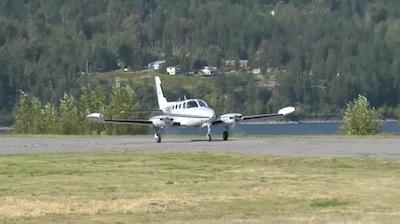Fri, Jan 05, 2018
Plane Went Down In Heavy Fog In Florida, Five Fatally Injured
The NTSB has released a preliminary report from an accident which occurred Christmas Eve in Bartow, FL which fatally injured all five people onboard the airplane.

According to the report, the Cessna 340 was departing from Bartow Municipal Airport (KBOW) for a flight to Key West, FL. The plane went down just after 0700. The private pilot and four passengers were fatally injured and the airplane was destroyed. The airplane was registered to Aviation Transportation LLC, and operated by the pilot as a personal flight. Instrument meteorological conditions prevailed at the time of the accident and an instrument flight plan had been filed.
According to two KBOW fixed base operator (FBO) employees, about 0630 the pilot requested that the airplane be towed from the pilot's hangar to the ramp. The pilot wanted a tow because he didn't want to taxi next to the other hangars with the reduced visibility due to the dense fog. The five occupants boarded the plane inside the hangar and remained inside the airplane during the tow. The pilot then very slowly taxied the airplane from the ramp to the end of runway 9L where the engine run-up was completed. The employees then heard the airplane takeoff and proceed to the east. They could not see the airplane because of the dense fog and low visibility, but they heard an explosion on the east side of the airport. They drove to the explosion and found the main wreckage on fire and no occupants were immediately noticeable.
Another witness, who is a helicopter pilot, observed the airplane taxiing to the runway and about 12 minutes later heard the airplane takeoff. He recorded a video of the airplane taxiing in the dense fog. During the takeoff, he heard a 'pop' and 3 seconds later heard the explosion near the end of runway 9L. He and a colleague drove to the accident site where they found the wreckage on fire and saw the FBO employees nearby. He estimated that the runway visual range was 600 to 800 ft due to the fog.
The responding FAA inspector stated that the main wreckage came to rest on the northeast side of runway 9L. At 0715, the automated weather observation station at BOW recorded calm wind, visibility less than ¼ statue mile, fog, overcast cloud layer at 300 ft, temperature 56°F, altimeter setting 30.18 inches of mercury. The weather conditions had been the same since 0635.
The pilot filed an IFR flight plan on a Garmin GPS device and received an IFR clearance from Tampa Air Traffic Control Tower. The pilot did not request a weather briefing from Flight Service. The BOW air traffic control tower was closed at the time of the accident.
(Image from file. Not accident airplane)
More News
We're Everywhere... Thanks To You! Even with the vast resources and incredibly far-reaching scope of the Aero-News Network, every now and then a story that should be reported on sl>[...]
From 2015 (YouTube Version): Oshkosh Reveals Many Treasures... Including Old Warbirds Full Of History While at EAA AirVenture 2015, ANN News Editor, Tom Patton, ventured out to vis>[...]
"The aircraft achieved the maximum recorded airspeed of 180 Knots IAS at about 08:08:42 UTC and immediately thereafter, the Engine 1 and Engine 2 fuel cutoff switches transitioned >[...]
Temporary Flight Restriction (TFR) A TFR is a regulatory action issued by the FAA via the U.S. NOTAM System, under the authority of United States Code, Title 49. TFRs are issued wi>[...]
Aero Linx: Aviation Without Borders Aviation Without Borders, a leading humanitarian aviation charity, uses its aviation expertise, contacts and partnerships to enable support for >[...]
 ANN FAQ: How Do I Become A News Spy?
ANN FAQ: How Do I Become A News Spy? Classic Aero-TV: The PB4Y-2 Privateer - A Priceless Aero-Treasure
Classic Aero-TV: The PB4Y-2 Privateer - A Priceless Aero-Treasure Aero-News: Quote of the Day (07.14.25)
Aero-News: Quote of the Day (07.14.25) ANN's Daily Aero-Term (07.14.25): Temporary Flight Restriction (TFR)
ANN's Daily Aero-Term (07.14.25): Temporary Flight Restriction (TFR) ANN's Daily Aero-Linx (07.14.25)
ANN's Daily Aero-Linx (07.14.25)



